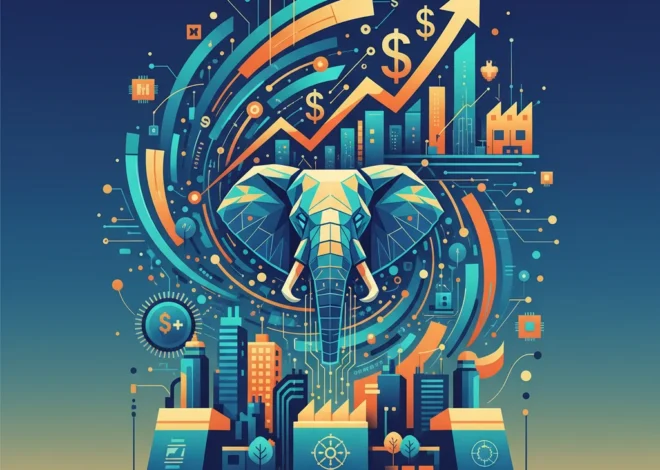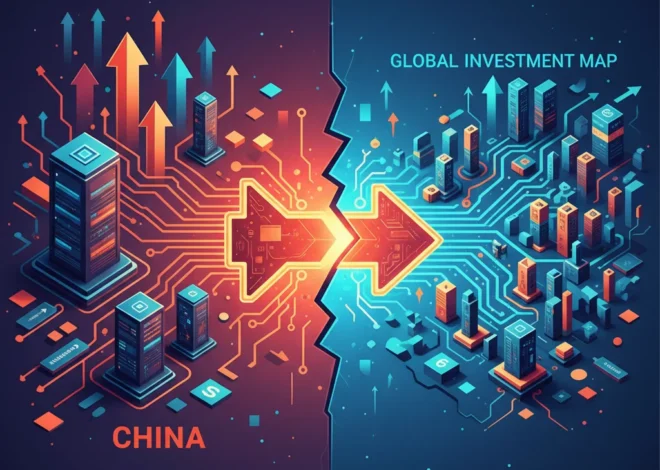
The $80 Billion AI Gamble: Are Tech Giants Building the Future or a Bubble?
The High-Stakes Bet on Artificial Intelligence
In the world of high finance and technology, few numbers can still shock a seasoned investor. Yet, the latest figures emerging from Silicon Valley are doing just that. The tech industry’s titans—Alphabet, Meta, and Microsoft—are embarking on an unprecedented investment spree, collectively earmarking a staggering $80 billion for capital expenditure this year alone, with the vast majority funneled into the burgeoning field of Artificial Intelligence. This monumental outlay of capital has cleaved the stock market in two, creating a fierce debate among investors, economists, and business leaders: Is this the necessary cost of building the next technological frontier, or a speculative bubble fueled by hype and a fear of missing out?
This isn’t just about upgrading a few servers or hiring more engineers. We are witnessing the construction of the fundamental infrastructure for a new economic era. This spending is a bet on a future where generative AI underpins everything from enterprise software and consumer applications to the very fabric of our digital interactions. But as the checks get larger, so do the questions. The central challenge for these giants is no longer about proving that AI is powerful, but proving it can be profitable. For investors navigating the volatile currents of today’s economy, understanding the dynamics of this AI arms race is paramount.
An Arms Race Measured in Billions: Deconstructing the Spend
To grasp the sheer scale of this endeavor, it’s essential to break down the numbers. The term “capital expenditure” (capex) refers to funds used by a company to acquire, upgrade, and maintain physical assets such as property, buildings, and, in this case, the technological backbone of AI: data centers, custom silicon, and tens of thousands of high-powered graphics processing units (GPUs) from chipmakers like Nvidia.
The recent earnings calls from Big Tech have laid bare their ambitious plans. Below is a snapshot of the projected capital expenditures for 2024, highlighting the massive financial commitment to building out AI capabilities.
| Company | Projected 2024 Capital Expenditure | Primary Focus of AI Investment |
|---|---|---|
| Microsoft | Projected to exceed $50 billion annually | Expanding Azure cloud infrastructure to support OpenAI models and enterprise Copilot services. |
| Alphabet (Google) | Expected to be “notably above” $32.3 billion from 2023 (source) | Building out data centers for its Gemini model, enhancing Google Cloud AI platforms, and integrating AI into Search and Ads. |
| Meta | Forecasted at $35-40 billion | Developing its open-source Llama models, powering AI features in its apps (Instagram, Facebook), and long-term metaverse ambitions. |
This spending isn’t just a line item on a balance sheet; it’s a strategic moat. By securing the computational power required to train and run cutting-edge AI models, these companies aim to create an insurmountable barrier to entry for smaller competitors. The race is on to achieve a level of scale and sophistication that becomes a utility, much like cloud computing did a decade ago. The question for the financial markets is whether the tollbooths they plan to erect on this new AI highway will justify the colossal construction costs. The Trillion-Dollar Blind Spot: Why Energy Efficiency is the Unsung Hero of Your Investment Portfolio
The Investor’s Dilemma: Patience for Innovation vs. Pressure for Profit
The stock market’s reaction to these spending announcements has been a fascinating case study in investor psychology. While Microsoft’s shares rose on the back of its strong Azure growth, which demonstrates a clear path to AI monetization, Meta’s stock took a significant hit. Investors balked when CEO Mark Zuckerberg stated the company would need to “invest significantly more… before we make much revenue” from its new AI products (source).
This divergence highlights the core tension at play. One camp of investors sees this as a necessary, long-term investment. They draw parallels to Amazon’s early, cash-burning years building out its e-commerce and AWS infrastructure, which eventually led to market dominance and immense profitability. In this view, securing a leadership position in the defining technology of the 21st century is a prize worth paying for, even if it means sacrificing short-term margins.
The other camp, however, is wary of what they perceive as a blank-check approach to spending. They see echoes of past tech bubbles where ambitious promises failed to translate into sustainable business models. This group is demanding a clearer roadmap to monetization. They want to know how, exactly, these multi-billion-dollar data centers will generate a return on investment (ROI). Their concern is that the current AI hype cycle could be leading to a misallocation of capital on a historic scale, impacting the broader economy and investment portfolios.
This creates a fascinating dynamic for anyone involved in finance and investing. The “picks and shovels” play—investing in a company like Nvidia that supplies the essential hardware—has been the obvious winner so far. But the ultimate prize lies with the platform owners. The critical metric to watch over the next 18 months won’t just be capex figures; it will be the “AI Revenue Delta”—the specific, attributable new income generated from these AI investments. The first company to consistently report and grow this number will win the market’s confidence and likely lead the next phase of the tech rally. The others may face a painful reckoning.
Forging the Path to Monetization: Three Titans, Three Strategies
While the spending is collective, the strategies for turning that investment into income are distinct. Each company is leveraging its unique strengths to carve out a profitable niche in the AI economy.
Microsoft’s Enterprise Play: Microsoft has the clearest and most immediate path to monetization. By integrating OpenAI’s technology into its existing products—from Azure cloud services to its Microsoft 365 Copilot—it is upselling a massive, captive customer base. For businesses already embedded in the Microsoft ecosystem, adding AI capabilities is a logical next step. This strategy turns AI from a speculative technology into a tangible productivity tool, a model that resonates well with both corporate clients and the stock market.
Alphabet’s Search for Synergy: Google’s parent company, Alphabet, is playing both offense and defense. It’s defending its core search and advertising business by infusing it with generative AI to provide richer, more conversational results. Simultaneously, it’s on the offense with Google Cloud, competing directly with Microsoft’s Azure to offer powerful AI models and infrastructure to developers and enterprises. The challenge for Alphabet is to innovate without cannibalizing its incredibly profitable advertising empire, a delicate balancing act that the market is watching with scrutiny.
Meta’s Long Game: Meta’s strategy is arguably the most ambitious and the most uncertain. In the short term, it’s using AI to refine its powerful advertising engine, improving targeting and engagement across Facebook and Instagram. This provides a solid foundation of ROI. However, its larger bet involves using its open-source Llama models to become the foundational software layer for a new ecosystem of AI applications, all while continuing its long-term, capital-intensive push into the metaverse. This dual-front investment strategy is what is testing investors’ patience the most. The End of an Era: Navigating the "Messy" Transition to a Post-American World
The Ripple Effect: Broader Implications for the Global Economy
This $80 billion spending spree is not happening in a vacuum. It is sending powerful shockwaves across the global economy, financial technology, and the very structure of the market.
Firstly, it solidifies the dominance of a handful of “picks and shovels” suppliers, most notably Nvidia. The insatiable demand for GPUs has given chipmakers immense pricing power and influence over the pace of AI development. Secondly, this capital injection could ignite a long-awaited productivity boom. As AI tools become more integrated into business workflows, they hold the potential to streamline operations, accelerate innovation, and drive economic growth in a way not seen since the dawn of the internet. This potential is a key reason why many in the banking and finance sectors are bullish on the long-term outlook despite short-term costs.
However, the risks are just as significant. The concentration of so much capital and power in a few companies raises competitive and regulatory concerns. Furthermore, there’s a debate in economics about whether this represents a healthy investment cycle or the inflation of a new tech bubble. The last major tech paradigm shift, the rise of the internet, was accompanied by the dot-com crash. While these tech giants are far more profitable and established than the startups of 1999, the sheer magnitude of the investment invites comparison and caution. The contrast with more decentralized technologies like blockchain, which saw its own hype cycle, is stark; here, the investment is hyper-centralized, creating single points of failure and immense corporate power. Beyond the Shadows: Why It’s Time to Retire the Term 'Shadow Banking'
The Verdict: A Necessary Revolution or an Unchecked Expense?
Ultimately, the $80 billion question remains unanswered. Are Alphabet, Meta, and Microsoft wisely constructing the foundational pillars of the next digital revolution, or are they engaged in a costly vanity project with an unclear payoff? The truth likely lies somewhere in between. The transformative potential of AI is undeniable, and failing to invest would be a strategic blunder of epic proportions.
For those involved in trading and investing, the path forward requires a nuanced perspective. It’s no longer enough to simply be “in tech.” Investors must now differentiate between companies with a clear, demonstrable path to AI monetization (like Microsoft) and those with more speculative, long-term visions (like Meta). The coming quarters will be critical. The market will be looking for more than just impressive AI demos; it will demand hard data on customer adoption, revenue growth, and, most importantly, a return on this historic capital investment. The AI arms race has begun, and while the initial shots have been fired in the form of capital expenditure, the war will be won through profitable execution.


